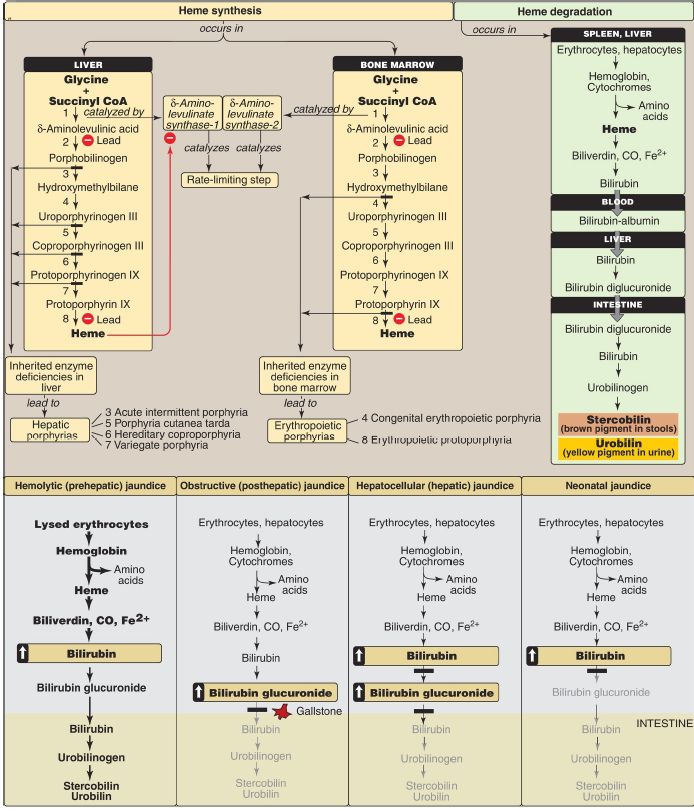


 النبات
النبات
 الحيوان
الحيوان
 الأحياء المجهرية
الأحياء المجهرية
 علم الأمراض
علم الأمراض
 التقانة الإحيائية
التقانة الإحيائية
 التقنية الحيوية المكروبية
التقنية الحيوية المكروبية
 التقنية الحياتية النانوية
التقنية الحياتية النانوية
 علم الأجنة
علم الأجنة
 الأحياء الجزيئي
الأحياء الجزيئي
 علم وظائف الأعضاء
علم وظائف الأعضاء
 الغدد
الغدد
 المضادات الحيوية
المضادات الحيوية|
Read More
Date: 25-12-2021
Date: 27-12-2021
Date: 23-9-2021
|
Amino acids : Conversion to Specialized Products
Amino acids are precursors of many nitrogen (N)-containing compounds including porphyrins, which, in combination with ferrous (Fe2+) iron, form heme (Fig. 1). The major sites of heme biosynthesis are the liver, which synthesizes a number of hemeproteins (particularly cytochrome P450 enzymes), and the erythrocyte-producing cells of the bone marrow, which are active in hemoglobin synthesis. In the liver, the rate of heme synthesis is highly variable, responding to alterations in the cellular heme pool caused by fluctuating demands for hemeproteins.
In contrast, heme synthesis in erythroid cells is relatively constant and is matched to the rate of globin synthesis. Heme synthesis starts with glycine and succinyl coenzyme A. The committed step is the formation of δ-aminolevulinic acid (ALA). This mitochondrial reaction is catalyzed by ALA synthase-1 (ALAS1) in the liver (inhibited by hemin, the oxidized form of heme that accumulates when heme is being underutilized) and ALAS2 in erythroid tissues (regulated by iron). Porphyrias are caused by inherited or acquired (lead poisoning) defects in heme synthesis, resulting in the accumulation and increased excretion of porphyrins or porphyrin precursors. Enzymic defects early in the pathway cause abdominal pain and neuropsychiatric symptoms, whereas later defects cause photosensitivity.
Degradation of heme occurs in the mononuclear phagocyte system, particularly in the liver and spleen. The first step is the production by heme oxygenase of biliverdin, which is subsequently reduced to bilirubin. Bilirubin is transported by albumin to the liver, where its solubility is increased by the addition of two molecules of glucuronic acid by bilirubin uridine diphosphate-glucuronosyltransferase (bilirubin UGT). Bilirubin diglucuronide (conjugated bilirubin) is transported into the bile canaliculi, where it is first hydrolyzed and reduced by gut bacteria to yield urobilinogen, which is further oxidized by bacteria to stercobilin. Jaundice (icterus) refers to the yellow color of the skin and sclerae that is caused by deposition of bilirubin, secondary to increased bilirubin levels in the blood.
Three commonly encountered types of jaundice are hemolytic (prehepatic), obstructive (posthepatic), and hepatocellular (hepatic) (see Fig. 1). Other important N-containing compounds derived from amino acids include the catecholamines (dopamine, norepinephrine, and epinephrine), creatine, histamine, serotonin, melanin, and nitric oxide.

Figure 1: Key concept map for heme metabolism. = Block in the pathway. [Note: Hepatocellular jaundice can be caused by decreased conjugation of bilirubin or decreased secretion of conjugated bilirubin from the liver into bile.] CoA = coenzyme A; CO = carbon monoxide; Fe = iron.



|
|
|
|
إدارة الغذاء والدواء الأميركية تقرّ عقارا جديدا للألزهايمر
|
|
|
|
|
|
|
شراء وقود الطائرات المستدام.. "الدفع" من جيب المسافر
|
|
|
|
|
|
|
بالصور: الامين العام للعتبة الحسينية المقدسة يجري جولة ميدانية للوقوف على آخر الاستعدادات الخاصة بمراسيم تبديل راية الإمام الحسين (ع)
|
|
|